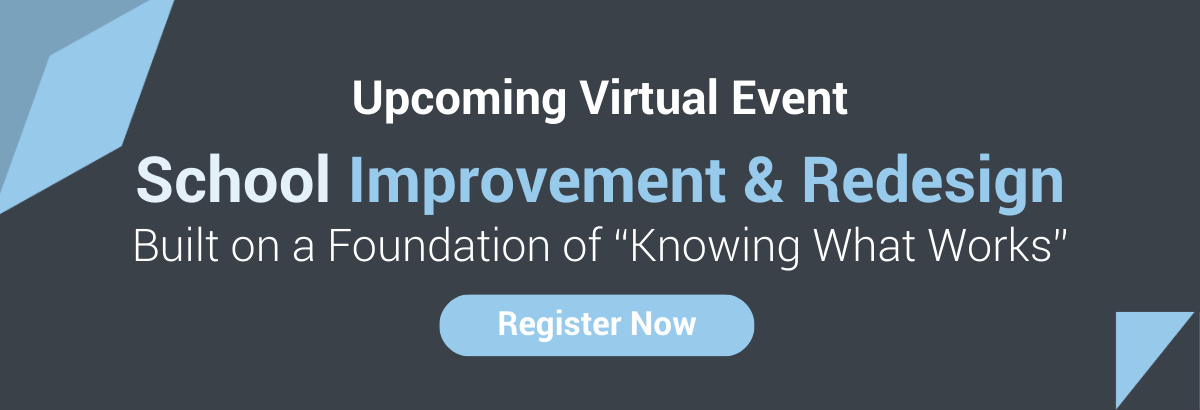Too often, schools are trapped inside cycles of belief that they are working on school improvement when in reality very little changes year-over-year. Does this sound familiar? It is time to shift this paradigm. School transformation efforts often fail because the typical school improvement playbook does not fully consider and appreciate what levers can actually drive transformational change. The approach to school improvement is often overly-complicated, compliance-driven, and based on outdated or inaccurate data. Instead, schools can rely on evidence based research demonstrating what does work to improve schools. At PLC Associates, we offer a robust research base on “what works in schools” and practitioners with pragmatic experience who deeply know the work. This is exactly why our models and strategies have such solid results.
Over the past 25+ years, I've designed and implemented, together with the team at PLC Associates, evidence-based strategies to support districts in yielding tangible positive results from their school improvement plans. Crafting a school improvement plan is only the first step; true transformation happens when the plan is translated into actionable strategies which yield tangible results. We call it implementation impact. It is critical to make sure your district/school has the right plan, grounded in high-impact strategies. And, to expedite results, schools can increase their likelihood of success by engaging external partners who provide onsite support for activating the plan, involve stakeholders and methodically keep you on the path of transformation. This is exactly why Michael Fullan, in his research, discusses co-accountability as a concept.
Here are few key steps your school and district can take to make your school improvement efforts more effective:
1.Assess the current state of your school and analyze your data
It is important to look at current data sets and examine whether improvements exist across a number of measures, from graduation rates, to literacy and numeracy, teaching and learning strategies, and student behavior. A thorough assessment will identify the specific needs of a school so that the plan addresses those effectively. This data can be collected through surveys, interviews, focus groups, and other methods. Our Tripod Data Triangle Surveys are an effective tool that collect data on student achievement, teacher effectiveness, and school culture. I encourage you to take advantage of these tools as they include exact metrics that are useful to build a solid plan for improved school performance.
2.Set clear and measurable goals
Well-defined and measurable goals provide a way to track progress and are essential to any successful school improvement effort. Each goal should include measures of success which serve as indicators of whether your school is moving in the right direction. We utilize a best practice at PLC Associates of conducting quarterly check-ins against these measurable goals. These check-ins involve a comprehensive discussion of the quantitative and qualitative data necessary to make thoughtful decisions about the path forward and determine any needed course corrections.
3.Invest in leadership development
We believe leadership can be found everywhere, not just with the school leader. School improvement efforts must engage leaders and staff to build systems and processes. With excellent leadership, we ensure our work permeates all levels, everyone feels connected, and new norms are sustainable. School leaders play a critical role as they are the drivers for ensuring we construct the right structures, practices, and systems that operate synergistically within the school. Our signature program, Leveraging Transformational Leadership, is specifically designed to support leaders in filling this role
4.Develop and define strategic action steps
Strategic action steps must be clear and definitive steps on the pathway toward your goals. These are not a check-off list, but instead steps that will guide your team towards meeting their goals. Identify who will be responsible for individual action steps and distribute responsibility across your team. People are less likely to resist when they understand how their work is part of a plan and are connected to others' tasks as the team works to collectively achieve results.
5.Establish critical mass support
This pertains to the wide range of stakeholders who should support the school transformation process. We know from the research of John Hattie that collective efficacy is at a 1.44 effect size. It is essential to garner support from staff members for the school improvement plan and build their capacity to implement it through clear instructional strategies that can make big differences at the classroom level. Contribution margin is a key concept as everyone in the school environment should see school improvement efforts as part of their job, regardless of role or title.
6.Monitor progress and adjust
Monitoring progress and making adjustments during the school improvement process is crucial.. Continuous improvement can only occur when adjustments are made along the way to ensure the plans remain effective and relevant. Monitoring progress should be based on ongoing data collection and feedback on student performance, instructional practices, systems checks, and other relevant metrics. Walkthroughs, both at the teacher and leader levels, serve as a solid tool to evaluate how well the plan is being implemented on the ground.
7.Celebrate often
Quick wins generate momentum for ongoing commitment while reinforcing the positive impact of the plan. School improvement plans can show tangible results quickly as it is a continuous process and not just a check of the box. Real results with tangible evidence spur enthusiasm and momentum for all involved stakeholders.
The journey towards school improvement is ongoing, and a dynamic approach that embraces change and collaboration is the key to sustained success. And remember, at its core, school improvement will be much more likely to succeed if you use data to identify the most impactful drivers of change.
Penny Ciaburri is the key architect of these models. At Education Elements, our PLC School Improvement experts have over 20 years of experience moving schools off accountability lists and transforming the learning culture through research- and evidence-based practices. Schedule a call with one of us to get started on your journey.





